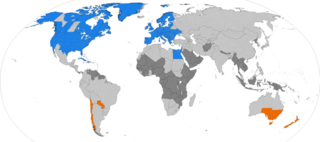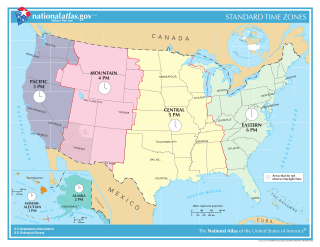Related Research Articles

Daylight saving time (DST), also referred to as daylight saving(s), daylight savings time, daylight time (United States and Canada), or summer time (United Kingdom, European Union, and others), is the practice of advancing clocks to make better use of the longer daylight available during summer, so that darkness falls at a later clock time. The typical implementation of DST is to set clocks forward by one hour in spring or late winter, and to set clocks back by one hour to standard time in the autumn (or fall in North American English, hence the mnemonic: "spring forward and fall back").

The history of standard time in the United States began November 18, 1883, when United States and Canadian railroads instituted standard time in time zones. Before then, time of day was a local matter, and most cities and towns used some form of local solar time, maintained by some well-known clock. The new standard time system was not immediately embraced by all.

The North American Central Time Zone (CT) is a time zone in parts of Canada, the United States, Mexico, Central America and some Caribbean islands.

The Eastern Time Zone (ET) is a time zone encompassing part or all of 23 states in the eastern part of the United States, parts of eastern Canada, and the state of Quintana Roo in Mexico.

The Mountain Time Zone of North America keeps time by subtracting seven hours from Coordinated Universal Time (UTC) when standard time (UTC−07:00) is in effect, and by subtracting six hours during daylight saving time (UTC−06:00). The clock time in this zone is based on the mean solar time at the 105th meridian west of the Greenwich Observatory. In the United States, the exact specification for the location of time zones and the dividing lines between zones is set forth in the Code of Federal Regulations at 49 CFR 71.

In the United States, time is divided into nine standard time zones covering the states, territories and other US possessions, with most of the country observing daylight saving time (DST) for approximately the spring, summer, and fall months. The time zone boundaries and DST observance are regulated by the Department of Transportation, but no single map of those existed until the agency announced intentions to make one in September 2022. Official and highly precise timekeeping services (clocks) are provided by two federal agencies: the National Institute of Standards and Technology (NIST) ; and the United States Naval Observatory (USNO). The clocks run by these services are kept synchronized with each other as well as with those of other international timekeeping organizations.

The Uniform Time Act of 1966, Pub. L.Tooltip Public Law 89–387, 80 Stat. 107, enacted April 13, 1966, was a Law of the United States to "promote the adoption and observance of uniform time within the standard time zones" prescribed by the Standard Time Act of 1918. Its intended effect was to simplify the official pattern of where and when daylight saving time (DST) is applied within the U.S. Prior to this law, each state had its own scheme for when DST would begin and end, and in some cases, which parts of the state should use it.
Time in New Zealand is divided by law into two standard time zones. The main islands use New Zealand Standard Time (NZST), 12 hours in advance of Coordinated Universal Time (UTC) / military M (Mike), while the outlying Chatham Islands use Chatham Standard Time (CHAST), 12 hours 45 minutes in advance of UTC / military M^ (Mike-Three).
In Australia, referendums are public votes held on important issues where the electorate may approve or reject a certain proposal. In contemporary usage, polls conducted on non-constitutional issues are known as plebiscites, with the term referendum being reserved solely for votes on constitutional changes, which is legally required to make a change to the Constitution of Australia.

Australia uses three main time zones: Australian Eastern Standard Time, Australian Central Standard Time and Australian Western Standard Time.

Most of the United States observes daylight saving time, the practice of setting the clock forward by one hour when there is longer daylight during the day, so that evenings have more daylight and mornings have less. Exceptions include Arizona, Hawaii, and the territories of American Samoa, Guam, the Northern Mariana Islands, Puerto Rico, and the United States Virgin Islands. The Uniform Time Act of 1966 established the system of uniform daylight saving time throughout the US.
Daylight Saving for South East Queensland (DS4SEQ) was a political party in Queensland, Australia. It was a single-issue party, run by volunteers, that advocated the introduction of Daylight Saving into Queensland, or at the very least into South East Queensland under a dual-time zone arrangement - with the remainder of the state to maintain standard time. The party proposed a possible dual time zone, which included the following 15 local and regional government areas: Brisbane, Fraser Coast, Gold Coast, Goondiwindi, Gympie, Ipswich, Lockyer, Logan, Moreton Bay, Redland, Scenic Rim, Somerset, Southern Downs, Sunshine Coast, and Toowoomba. The party was officially registered with the Electoral Commission of Queensland (ECQ) in December 2008 and was not registered with the Australian Electoral Commission. In August 2012, DS4SEQ submitted a request to the ECQ to deregister the party, and this process was finalised in October 2012. DS4SEQ maintains a presence as a lobby group and may potentially re-register as a political party in the future. Jason Furze was leader of the party from December 2008 until June 2011.

Daylight saving time was trialled in the state of Queensland, Australia, during the 1989/90 season, with the trial extended for a further two years—1990/91 and 1991/92. The last full day of daylight saving in Queensland was Saturday 29 February 1992, with clocks officially wound back an hour on Sunday 1 March at 3am.
Samoa uses UTC+13:00 as standard time. Until the end of 2011, it used UTC−11:00 as standard time. Samoa observed daylight saving time from 2010 to 2021.
In Canada, daylight saving time (DST) is observed in nine of the country's ten provinces and two of its three territories—though with exceptions in parts of several provinces and Nunavut.

Each state and territory of Australia determines whether or not to use daylight saving time (DST). However, during World War I and World War II all states and territories had daylight saving by federal law, under the defence power in section 51 of the constitution. In 1968, Tasmania was the first state since the war to adopt daylight saving. In 1971, New South Wales, Queensland, South Australia, Victoria, and the Australian Capital Territory also adopted daylight saving, while Western Australia and the Northern Territory did not. Queensland abandoned daylight saving in 1972. Queensland and Western Australia have observed daylight saving over the past 40 years from time to time on a trial basis.
Daylight saving time in the Americas is the arrangement in the Americas by which clocks are advanced by one hour in spring and moved back in autumn, to make the most of seasonal daylight. The practice is widespread in North America, with most of Canada and the United States participating, but much less so in Central and South America.

As of 2022, daylight saving time is used in the following Asian countries:

African countries, apart from Egypt, do not use daylight saving time (DST) although some did in the past. Only the territories of the Canary Islands, Ceuta and Melilla (Spain) and Madeira (Portugal) implement DST from the last Sunday in March to the last Sunday in October. Although these regions politically belong to Europe, they are geographically part of Africa. They have DST schedules according to European Union rules.

Daylight saving time (DST), also known as summer time, is the practice of advancing clocks during part of the year, typically by one hour around spring and summer, so that daylight ends at a later time of the day. As of 2024, DST is observed in most of Europe, most of North America and parts of Africa and Asia around the Northern Hemisphere summer, and in parts of South America and Oceania around the Southern Hemisphere summer. It was also formerly observed in other areas.
References
- ↑ Daylight Saving Act 1971 No. 8159 (Vic.) for the summer of 1971/72; Summer Time Act 1972 No. 8297 (Vic.) since summer 1972
- ↑ Australian Government - Bureau of Meteorology. "Daylight Saving Time - Implementation Dates of Daylight Saving Time within Australia" . Retrieved 2010-07-27.
- ↑ "1992 Queensland Daylight Saving Referendum" (PDF). Retrieved 2010-07-25.[ permanent dead link ]
- ↑ "Daylight Saving group launched as new Qld political party". ABC News. 2008-12-14. Retrieved 2010-07-25.
- ↑ "Total Candidates Nominated for Election by Party – 2009 State Election". Electoral Commission of Queensland (ECQ). Archived from the original on 2011-02-26. Retrieved 2010-06-19.
- ↑ "Daylight Saving for South East Queensland Referendum Bill 2010" (PDF). 14 April 2010. Retrieved 2010-07-25.
- ↑ "Daylight saving silence 'deafening'". 16 June 2011. Retrieved 2011-06-19.
- ↑ Western Australian Electoral Commission (2005). "Referendums/Referendum Results". Archived from the original on 2006-11-29. Retrieved 2007-03-03.
- ↑ Jessica Strutt (24 March 2007). "Daylight saving support sinks". The West Australian. Archived from the original on 3 February 2009. Retrieved 30 October 2012.
- ↑ Brendon Grylls (27 February 2007). "The Nationals give Parliament notice of daylight saving Bill" (PDF). Archived from the original (PDF) on 26 June 2008. Retrieved 2007-03-03.
- ↑ ABC News (2009). "WA to vote on daylight saving". Australian Broadcasting Corporation . Retrieved 2009-01-30.
- ↑ The West Australian (2009). "Daylight saving issue dead for next 20 years: Premier". Archived from the original on 2009-05-21. Retrieved 2009-05-17.
- 1 2 "Daylight saving begin". Fiji Daily Post. 14 November 2009. Archived from the original on 14 March 2022. Retrieved 4 November 2012.
- ↑ "Amendments to daylight savings". Government of Fiji. Archived from the original on October 20, 2012. Retrieved 4 November 2012.
- ↑ "No DST Start in Fiji in 2021". www.timeanddate.com.
- ↑ "and". Aa.usno.navy.mil. Archived from the original on 2010-05-30. Retrieved 2010-06-25.
- ↑ HawaiiAnswers.com: Has Hawaii ever been on daylight saving time, even for a very short time? If yes, when? The page cites The American Atlas, 5th ed., by Thomas G. Shanks. It is also worth noting that at one time Hawaii Standard Time was UTC-10:30.
- ↑ "Hawaii Revised Statutes, §1-31". Capitol.hawaii.gov. Retrieved 2010-06-25.
- ↑ "Daylight savings scrapped". Samoa Observer. 20 September 2021. Retrieved 23 September 2021.